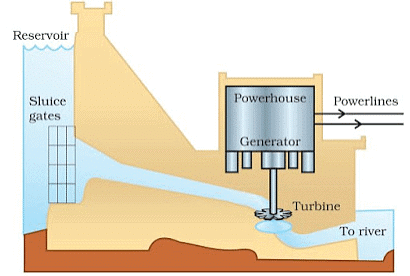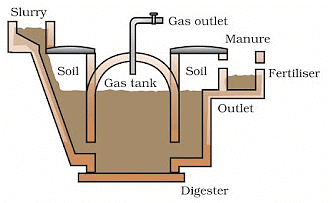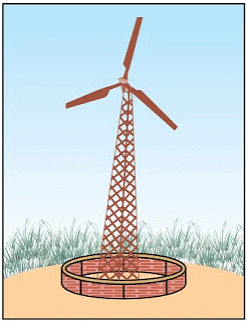Sources of Energy Class 10 Notes Science
Introduction
Energy is found in different forms, and one form can be converted into another. An energy source is something that provides a large amount of energy in a useful form over a long period.
Need for Energy
- Cooking food.
- Lighting up areas.
- Transporting goods and people.
- Operating machines.
- Industrial activities.
- Agricultural work.
Qualities of a Good Source of Energy
(i) Which would do a large amount of work per unit mass.
(ii) Cheap and easily available.
(iii) Easy to store and transport.
(iv) Safe to handle and use.
(v) Does not cause environmental pollution.
Characteristics of a Good Fuel
- Fuels: The materials which are burnt to produce heat energy are known as fuels.
Example: wood, coal, LPG, kerosene. - Characteristics of a Good Fuel
- High calorific value (give more heat per unit mass).
- Burn without giving out any smoke or harmful gases.
- Proper ignition temperature.
- Cheap and easily available.
- Easy to handle, safe to transport.
- Convenient to store.
- Burn smoothly.
Sources of Energy
Conventional Sources of Energy
- Sources of energy which are known to most of the people.
Example: fossil fuels, bio mass etc.
Fossil Fuels
- Fuels developed from the fossils e.g., coal, petroleum.
- Take millions of years to form.
- Available in very limited amount.
- These are non-renewable sources of energy.
- India has about 6% share in the world reserved coal, that may last 250 years more at the present rate of consumption.
Pollution Caused by Fossil Fuels
- Released oxides of carbon, nitrogen and sulphur (acidic in nature) which causes acid rain that damages trees, plants, reduces fertility of soil.
- Produces large amount of CO2 in the atmosphere which causes green house effect leading to excessive heating of the earth.
Controlling Pollution Caused by Fossil Fuels
- Increasing the efficiency of the combustion process.
- Using various techniques to reduce the escape of harmful gases and ashes into the surroundings.
Thermal Power Plants

- A power plant which uses heat energy to generate electricity.
- Burning of fossil fuels produces steam to run turbines.
- Set up (power plants) near the coal and oil fields to minimize the cost of transportation and production.
- Transmission of electricity is more efficient.
Hydro Power Plants
- Convert the potential energy of falling water into electricity.
- Hydro power plants are associated with Dams.
- Around 25% of our country’s energy requirement is met by Hydro Power plants.
Advantages of Hydro power plants
- No environmental pollution.
- Flowing water is a renewable source of electric energy.
- Construction of dams prevents flooding of rivers, provide water for irrigation.
Disadvantages of Hydro Power Plants
- Large areas of agricultural land, a vast variety of flora and fauna, human settlements get submerged in the water of reservoir formed by the dam.
- Large ecosystems are destroyed.
- Vegetation that submerged under water rots under anaerobic conditions and produces large amount of methane which is a green house gas.
- Creates the problems of satisfactory rehabilitation of displaced people.

Biomass
Biomass refers to the dead parts of plants and trees, as well as the waste materials of animals and humans.
Wood as Fuel
Wood, being biomass, has been used as a fuel for a long time.
Disadvantages of using wood as fuel:
- Produces a lot of smoke on burning.
- Do not produce much heat.
- Thus by improvement in technology we can improve the efficiency of traditional sources of energy.
- For example: wood can be converted into much better fuel called charcoal.
Charcoal as Fuel
- When wood is burnt in limited supply of air, then water and other volatile materials gets removed and charcoal is formed.
- Wood on limited supply of Oxygen gas get converted into Charcoal.
Charcoal is better fuel than wood because
- It has higher calorific value than wood.
- Does not produce smoke while burning.
- It is a compact fuel, easy to handle and convenient to use.
Cow Dung as Biomass
It is biomass but it is not good to burn cow dung directly as fuel because:
- produces lot of smoke.
- cowdung does not burn completely, produces lot of ash as residue.
- low calorific value.
- by making bio gas (or gobar gas) from cow dung, we get a smokeless fuel.
Biogas
It is produced in a biogas plant.
- Anaerobic micro organisms decomposes the complex compound of the cow dung+water slurry.
- It takes few day for the decomposition process and generate gases like methane, CO2, hydrogen and hydrogen sulphide.
- Bio gas is stored in the gas tank above the digester from which they are drawn through pipes for use.

Advantages of Bio gas
- It is an excellent fuel as it contains upto 75% methane (CH4 ).
- It burns without smoke.
- Leaves no residue like ash in wood & coal burning.
- Heating capacity is high.
- It is also used for lighting.
- Slurry left behind is used as excellent manure rich in nitrogen and phosphorus.
- Safe and efficient method of waste disposal.
Wind energy
- Unequal heating of the landmass and water bodies by solar radiations generate air movement and causes wind to blow.

- Uses of kinetic energy generated by wind energy
- to generate electricity by turning the rotor of the turbine.
- to lift water from the well.
- to run the flour mills.
- The output of a single wind mill is quite small so a number of windmills are erected over a large area called wind energy farm.
- The minimum wind speed for wind mill to serve as a source of energy is 15-20 KmPH.
- Advantages of wind energy
- Eco-friendly.
- Efficient source of renewable energy.
- No recurring expenses for production of electricity.
- Disadvantages of wind energy
- Wind energy farms need large area of land.
- Difficulty in getting regular wind speed of 15-20 KmPH.
- Initial cost of establishing wind energy farm is very high.
- High level of maintenance of blades of wind mill.
- Denmark is called the ‘Country of Winds’.
- India is ranked 5 th in harnessing wind energy for the production of electricity.
- In India largest wind energy farm has been established near Kanyakumari in Tamil Nadu and it generates 380 MW of electricity.
Alternate or Non-conventional Sources of Energy
- Day by day, our demand for energy increases, so there is a need for another source of energy.
Reasons for alternate sources of energy
- The fossil fuel reserves in the earth are limited which may get exhausted soon if we use them at the current rate.
- Reduce the pressure on fossil fuels making them last for a much longer time.
- To reduce the pollution level and to save the environment.
Solar Energy
- Sun is the ultimate source of energy.
- Energy obtained from the sun is called solar energy.
Solar constant = 1.4 KJ/s/m2 - Outer edge of the earth receives solar energy equal to 1.4 KJ/s/m2 or 1.4 KW/m2 [... 1 KJ/s = 1 KW]
Solar energy devices:
(i) Solar cooker
(ii) Solar water heater
(iii) Solar cells
Geothermal Energy
- ‘Geo’ means ‘earth’ and ‘thermal’ means ‘heat’.
- Geothermal energy is the heat energy from hot rocks present inside the earth.
- When underground water comes in contact with ‘hot spot’, steam is generated. Steam trapped in rocks is routed through pipes to a turbine and used to generate electricity.
Advantages of Geothermal energy
- Economical: Geothermal energy is cost-effective to use, making it an attractive option for energy generation.
- Environmentally Friendly: Geothermal energy does not cause pollution, making it a clean and sustainable energy source.
Limitations of Geothermal energy
- Availability: Geothermal energy is not accessible in all locations, as it requires specific geological conditions.
- Drilling Challenges: Deep drilling into the Earth to obtain geothermal energy is both difficult and expensive, posing a significant challenge to its widespread use.
- Operational Power Plants: Countries like New Zealand and the USA have operational power plants that successfully harness geothermal energy.
Nuclear Energy
- The energy released during a nuclear reaction is called nuclear energy.
- It can be obtained by two types of nuclear reactions:
(i) Nuclear fission
(ii) Nuclear fusion
Nuclear Fission
- ‘Fission’ means split up.
- The process in which the heavy nucleus of a radioactive atom (such as uranium, plutonium or thorium) split up into smaller nuclei when bombarded with low energy neutrons, is called nuclear fission.
- A tremendous amount of energy is produced.
- U-235 is used as a fuel in nuclear reactor in form of uranium rods.
Working of Nuclear Fission
- In a nuclear reactor self sustaining chain reaction releases energy at a controlled rate, which is used to produce steam and further generate electricity.
Major Nuclear Power Plants
(i) Tarapur (Maharashtra)
(ii) Rana Pratap Sagar (Rajasthan)
(iii) Kalpakkam (Tamil Nadu)
(iv) Narora (U. P.)
(v) Kakrapar (Gujrat)
(vi) Kaiga (Karnataka)
Nuclear Fusion
- When two nuclei of light elements (like hydrogen) combine to form a heavy nucleus (like helium) and tremendous amount of energy is released is called nuclear fusion.

- Very-very high temperature and pressure is needed for fusion.
- Hydrogen bomb is based on this phenomenon.
- Nuclear fusion is the source of energy in the sun and other stars.
Advantage of Nuclear Fusion
- Production of large amount of useful energy from a very small amount of nuclear fuel.
- Does not produce green house gases like CO2.
Limitations of Nuclear Fusion
- Environmental contamination due to improper nuclear waste storage and its disposal.
- Risk of accidental leakage of harmful radiations.
- High cost of installation.
- Limited availability of nuclear fuel.
Environmental Consequences
- Exploiting any source of energy disturbs the environment in some way or the other.
- The source we would choose depends upon following the factors:
(i) Ease of extracting energy from the source.
(ii) Cost of extracting energy from the source.
(iii) Efficiency of technology available to extract energy.
(iv) The environmental damage caused by using that source. - In other words, no source of energy is said to be pollution free. Some source are cleaner than the other.
For example, solar cells may be pollution free but the assembly of the device would have cause some environmental damage.
Non-renewable Sources of Energy
- Sources that will get depleted some day.
- For example: Fossil fuel
Renewable Sources of Energy
- Energy sources that can be regenerated and that will last for ever.
- For example: Wind energy, water energy.
FAQs on Sources of Energy Class 10 Notes Science
| 1. What are the main sources of energy used today? |  |
| 2. How do renewable energy sources benefit the environment? |  |
| 3. What is the difference between renewable and non-renewable energy sources? |  |
| 4. Why is it important to transition to renewable energy? |  |
| 5. What role does nuclear energy play in the current energy mix? |  |
















